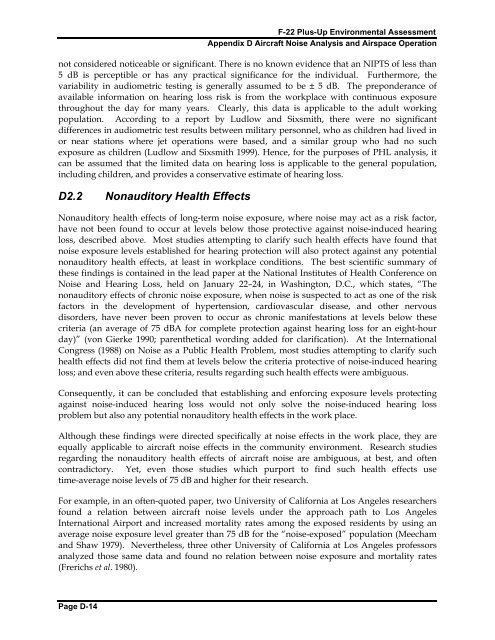F-22 Plus-Up Environmental Assessment - Joint Base Elmendorf ...
F-22 Plus-Up Environmental Assessment - Joint Base Elmendorf ...
F-22 Plus-Up Environmental Assessment - Joint Base Elmendorf ...
You also want an ePaper? Increase the reach of your titles
YUMPU automatically turns print PDFs into web optimized ePapers that Google loves.
F-<strong>22</strong> <strong>Plus</strong>-<strong>Up</strong> <strong>Environmental</strong> <strong>Assessment</strong><br />
Appendix D Aircraft Noise Analysis and Airspace Operation<br />
not considered noticeable or significant. There is no known evidence that an NIPTS of less than<br />
5 dB is perceptible or has any practical significance for the individual. Furthermore, the<br />
variability in audiometric testing is generally assumed to be ± 5 dB. The preponderance of<br />
available information on hearing loss risk is from the workplace with continuous exposure<br />
throughout the day for many years. Clearly, this data is applicable to the adult working<br />
population. According to a report by Ludlow and Sixsmith, there were no significant<br />
differences in audiometric test results between military personnel, who as children had lived in<br />
or near stations where jet operations were based, and a similar group who had no such<br />
exposure as children (Ludlow and Sixsmith 1999). Hence, for the purposes of PHL analysis, it<br />
can be assumed that the limited data on hearing loss is applicable to the general population,<br />
including children, and provides a conservative estimate of hearing loss.<br />
D2.2 Nonauditory Health Effects<br />
Nonauditory health effects of long-term noise exposure, where noise may act as a risk factor,<br />
have not been found to occur at levels below those protective against noise-induced hearing<br />
loss, described above. Most studies attempting to clarify such health effects have found that<br />
noise exposure levels established for hearing protection will also protect against any potential<br />
nonauditory health effects, at least in workplace conditions. The best scientific summary of<br />
these findings is contained in the lead paper at the National Institutes of Health Conference on<br />
Noise and Hearing Loss, held on January <strong>22</strong>–24, in Washington, D.C., which states, “The<br />
nonauditory effects of chronic noise exposure, when noise is suspected to act as one of the risk<br />
factors in the development of hypertension, cardiovascular disease, and other nervous<br />
disorders, have never been proven to occur as chronic manifestations at levels below these<br />
criteria (an average of 75 dBA for complete protection against hearing loss for an eight-hour<br />
day)” (von Gierke 1990; parenthetical wording added for clarification). At the International<br />
Congress (1988) on Noise as a Public Health Problem, most studies attempting to clarify such<br />
health effects did not find them at levels below the criteria protective of noise-induced hearing<br />
loss; and even above these criteria, results regarding such health effects were ambiguous.<br />
Consequently, it can be concluded that establishing and enforcing exposure levels protecting<br />
against noise-induced hearing loss would not only solve the noise-induced hearing loss<br />
problem but also any potential nonauditory health effects in the work place.<br />
Although these findings were directed specifically at noise effects in the work place, they are<br />
equally applicable to aircraft noise effects in the community environment. Research studies<br />
regarding the nonauditory health effects of aircraft noise are ambiguous, at best, and often<br />
contradictory. Yet, even those studies which purport to find such health effects use<br />
time-average noise levels of 75 dB and higher for their research.<br />
For example, in an often-quoted paper, two University of California at Los Angeles researchers<br />
found a relation between aircraft noise levels under the approach path to Los Angeles<br />
International Airport and increased mortality rates among the exposed residents by using an<br />
average noise exposure level greater than 75 dB for the “noise-exposed” population (Meecham<br />
and Shaw 1979). Nevertheless, three other University of California at Los Angeles professors<br />
analyzed those same data and found no relation between noise exposure and mortality rates<br />
(Frerichs et al. 1980).<br />
Page D-14
















